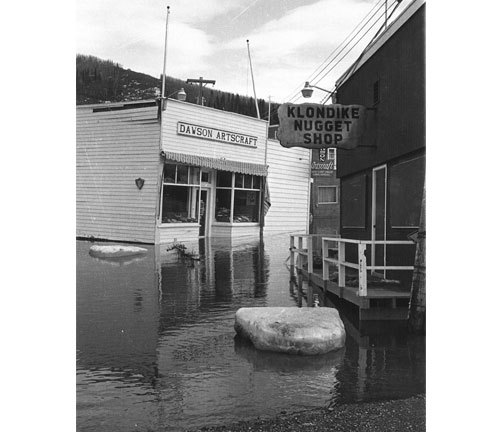Disaster! Dawson City Flood
The swollen Yukon River broke free of it's icy mantle and poured into Dawson City.
By Whitehorse Star on May 3, 1979
Whitehorse Star, Thursday, May 3, 1979
Disaster! Dawson City Flood
The swollen Yukon River broke free of it's icy mantle and poured into Dawson City.
A heavy snowfall and spring ice-jams on three rivers caused the Yukon River to pour into this historic gold rush town despite last-minute efforts by the town's residents to sand bag the river.
The water burst through the makeshift bank at midnight but fortunately most people were awake and alert so there were no lives lost.
This was not the first time the gold mining settlement had been ravaged by flooding water. History shows Dawson City was flooded 22 times since 1898.
Most of the floods were minor. Others were serious. Floods in 1925, 1944,1969 and 1966 caused considerable damage.
That fateful night, a blower rounded through the streets of Dawson and drew people down to the river front to pile sand bags. At that point, former Klondike MLA Fred Berger declared it was an exercise in futility. The river then poured over the banks. Within 40 minutes of breaching the dyke, the river had flooded the town up to two metres in depth in some places.
The flood was caused by ice jams on the Yukon, Indian and Klondike Rivers. Buildings which shifted off their foundations began drifting among the chunks of ice. Silty water filled homes and turned trailers upside down. A greenhouse with a wood heater still burning inside bobbed along the flow. Historic artifacts washed away.
After the waters receded, Dawsonites recounted stories of the flood. Postmaster Lambert Curzon lost his house and most of his things that night. The Front Street building he was rented lifted, along with a log cabin, a dog house and some propane tanks. It floated a block south before coming to rest in a hollow. It was totally flooded when he found it later. "A crib board came floating out the window," he said. "Inside, the water was a foot and a half from the ceiling. I was wiped out."
Oddly enough, Curzon credits the flood with turning his life around and giving him a purpose. He sought a better job, bought some property on 7th Avenue, later sold that and built a large house at the north end of the same street. "It really gave me a boot to do something." But it made him careful too. "I've definitely stayed on high ground since then."
Parks Canada collections curator Michael Gates remembers quite clearly the events surrounding the flood. "The flood started at midnight, but during the day preceding, people were standing along the dyke watching the water come up and down with apprehension. I came to work at 9-10 p.m. and looked in the basement. Water had poured in."
Gates proceeded to move documents, filled his truck with bedding and moved to a house he was taking care of on higher ground. "I filled up the bathtub and started waiting for radio reports. At that time, it was barely dark. I stayed up all night and could see the water coming."
In the morning, he paddled around town in a canoe to look at the damage. "All kinds of things were floating around, wood and sidewalks, and I could smell diesel fuel everywhere."
"One home was left in a hurry. Everything was left in place on the dinner table." And he observed a greenhouse floating, buoyant with air, with its wood heater still burning. "At that time, we were approaching the federal election.
The residence I was living in floated out into the middle of Main Street."
Since Main Street was the dividing line between the two ridings. Gates was unsure which riding his main residence was in.
Later that day, the water ebbed away into the river after work crews dug a hug trench in the Front Street dyke to let water out.
For the next few day, residents were warned to avoid walking in any water because of the danger of stepping in the wooden sewer boxes, since the lids had floated away. Warnings were issued to boil water before drinking it, as flood waters were mixed with fuel and gas. In addition, sewage lines were backed up by the flood.
Gates said the Parks Canada had 20 some properties in the area of the flood plain. Some emerged intact while others shifted or lifted off on their foundations and floated away.
Work on old structures and artifacts continued for many years after the flood. Parks Canada spent hundreds of thousands of dollars repairing and restoring flood damaged buildings and artifacts, he said. A dozen homes were written off by assessors, leaving owners permanently homeless and with nothing to build from.
The day after the flood, the Yukon government announced that 20,000 pounds of food supplies and equipment were being airlifted to the stricken town. The Emergency Measures Organization arranged for water pumps to be flown in.
Approximately 270 claims for flood damage totaling $2 million were registered. The Yukon government created a disaster assistance policy to help pay the costs of getting Dawson City back to normal.
But the flood was not the last of things to come. More than two weeks later, a fire destroyed one of three stores in Dawson.
The DCW Trading Post and a warehouse was gutted by flames, another blow to residents recovering from a disastrous flood. The DCW was Dawson's only hardware store, major grocery outlet, mail order shop, camera supply depot and magazine rack.
Conservative MLA Alan Nordling, then manager of the Klondike Visitors Association, dryly commented: "Flood, fire, and now maybe famine."

Be the first to comment